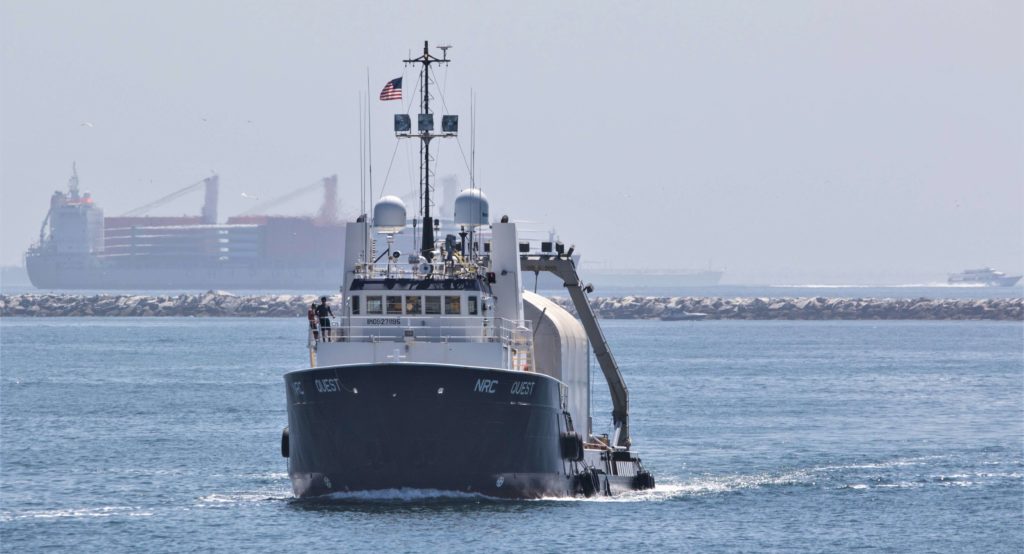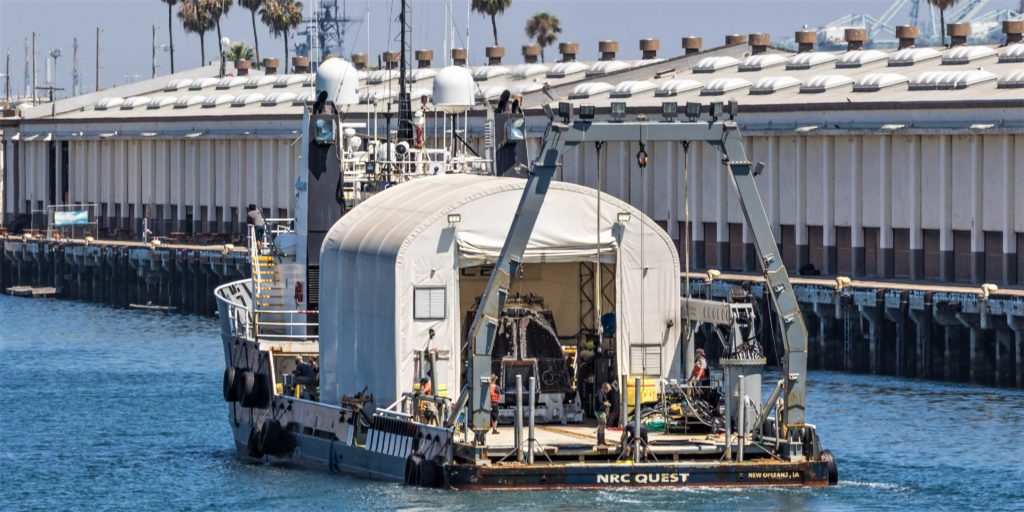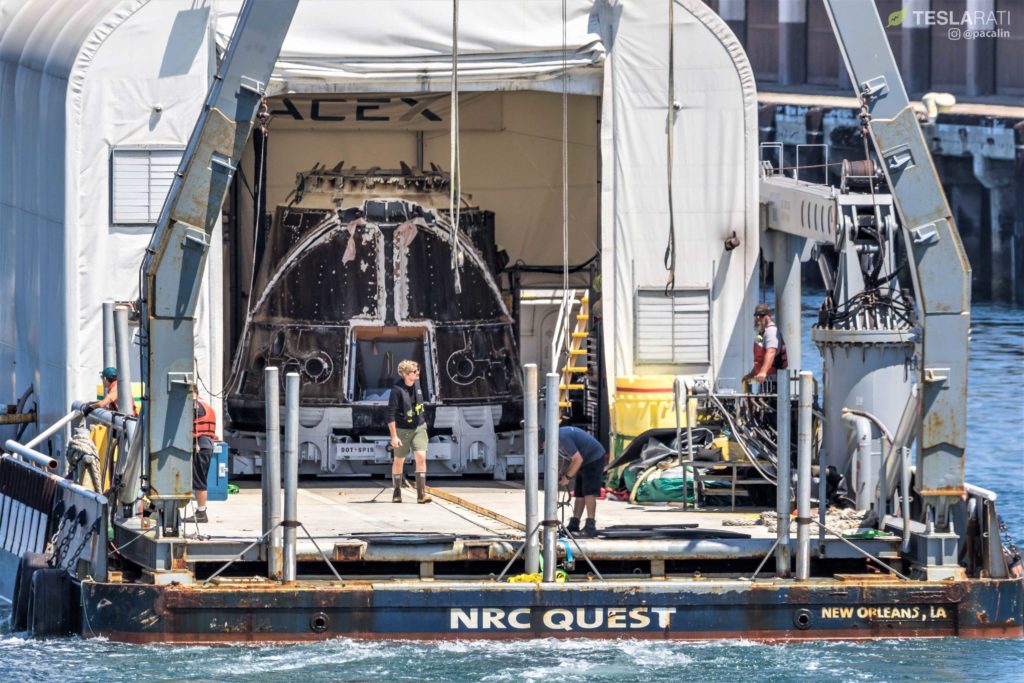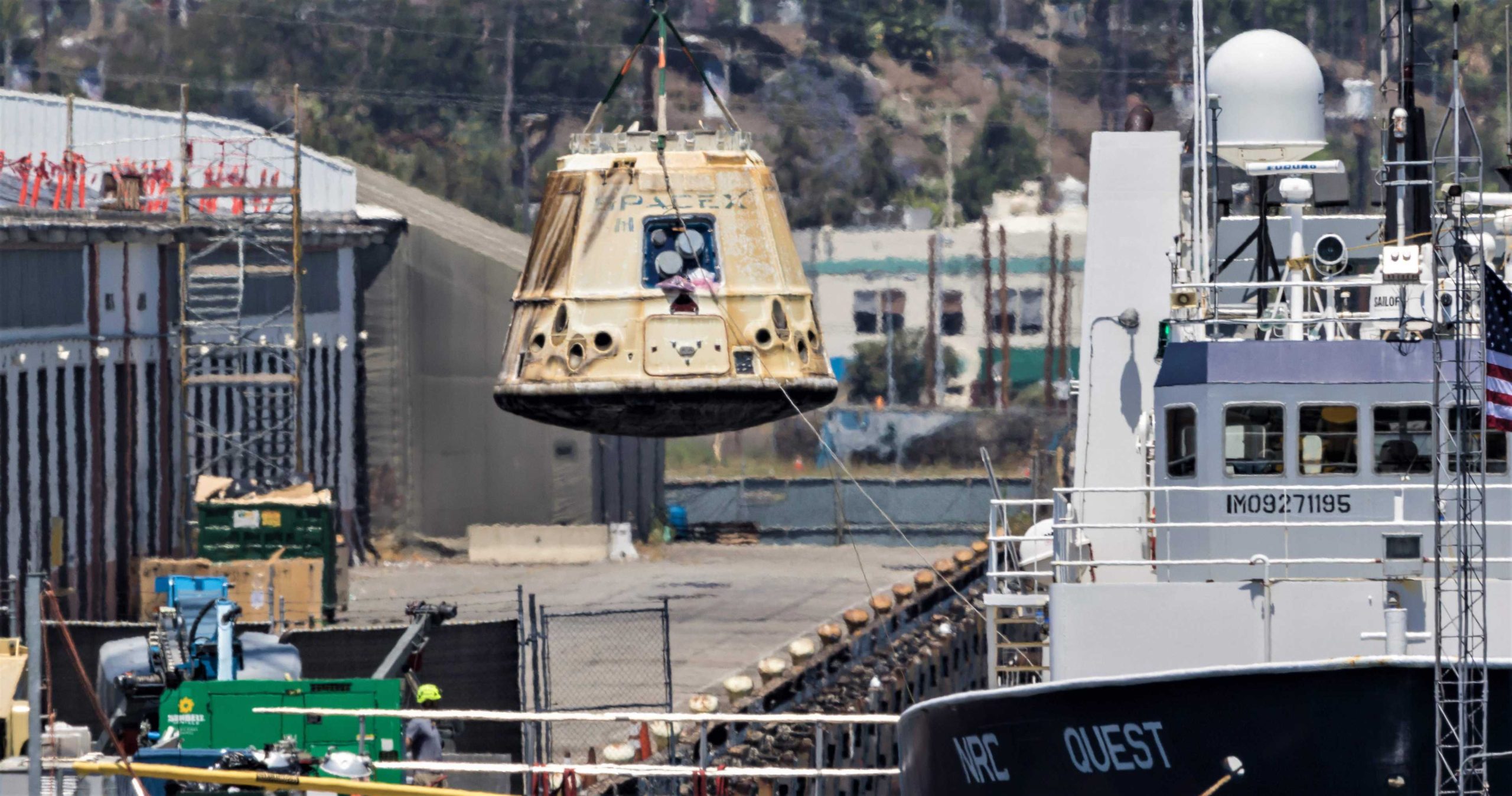
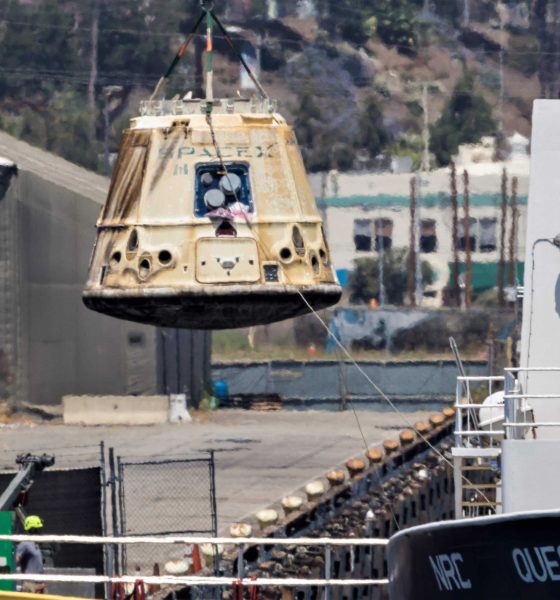
News
SpaceX’s Cargo Dragon spacecraft returns to Earth after second orbital mission
SpaceX’s workhorse Cargo Dragon spacecraft has returned from its 16th successful mission to orbit, in this case as the fourth flight-proven Dragon capsule.
CRS-15 carried several thousand pounds of cargo to the International Space Station on June 29 and transported a roughly equivalent amount of invaluable cargo and scientific experiments from orbit back to Earth – incredibly, SpaceX’s Cargo Dragon is currently the only operational spacecraft in the world able to return an appreciable amount of (non-human) cargo back to Earth. The toasty-looking vehicle was captured after a soft landing in the Pacific Ocean and transported back to Port of San Pedro aboard SpaceX vessel NRC Quest between August 3rd and 5th.
SpaceX’s Dragon capsule is back at Port of LA, full of science, after a month spent at the International Space Station. #spacex #nasa pic.twitter.com/jWhZQTubgK
— Pauline Acalin (@w00ki33) August 5, 2018
Cargo Dragon is the only commercial orbital spacecraft in history that has been reused and stands in the company of a tiny handful of reusable orbital vehicles built or procured by countries, including the Space Shuttle, a one-off Mercury capsule reflight, and a few others. While most of each Cargo Dragon can be reused, the rear segment (known as a trunk) will always be expended, and the vehicle’s parachutes and heatshield also have to be replaced after each ocean recovery.
Still, the vast majority of the cost and effort that goes into producing and operationalizing Cargo Dragon is contained within the capsule itself, including extremely sensitive electronics, docking equipment, aluminum, titanium, and carbon composite structures, and its 12 Draco thrusters for maneuvering on orbit, as well as propellant tanks and many dozens of other long-lead components.

According to CEO Elon Musk and COO Gwynne Shotwell, Cargo Dragon was certified from the start with a spacecraft lifespan of three orbital missions, and SpaceX now has four Cargo Dragon capsules in various states of storage or refurbishment, some readying for their third and final launches over the next eighteen months. Aside from those twice-flown Dragons, three once-flown capsules remain in the flight-proven Dragon roost – more than enough to complete the five cargo missions remaining in SpaceX’s CRS-1 (Commercial Supply Services) contract. CRS-1’s last (20th) contracted mission is currently scheduled for early 2020, after which a modified version of Cargo Dragon (Dragon 2) will take over all future SpaceX resupply missions to the ISS.
- SpaceX’s CRS-15 Cargo Dragon returns to Port of San Pedro, 08/05/18. (Pauline Acalin)
- SpaceX’s CRS-15 Cargo Dragon returns to Port of San Pedro, 08/05/18. (Pauline Acalin)
- SpaceX’s CRS-15 Cargo Dragon returns to Port of San Pedro, 08/05/18. (Pauline Acalin)
- Cargo Dragon C110 is craned from NRC Quest to SpaceX’s Port of San Pedro berth, 08/05/18. (Pauline Acalin)
Back at the docks, Teslarati photographer Pauline Acalin managed to capture some gorgeous noon-lit photos of Cargo Dragon capsule C110’s (Dragon 1, serial #10) return from the Pacific to Port of San Pedro, even catching a rare glimpse of the capsule’s extra toasty rear and parachute compartment as SpaceX vessel NRC Quest sailed by. Patience further paid off, and she was able to watch as the capsule was craned from Quest to dock and later caught a few close-ups of the spacecraft before it was rushed under cover to extricate dozens of time-sensitive scientific experiments and offload several thousand pounds of miscellaneous cargo.
SpaceX’s next Cargo Dragon launch is targeting the end of November 2018 and will mark the spacecraft’s first launch atop Falcon 9 Block 5, likely with both a flight-proven booster and capsule.
For prompt updates, on-the-ground perspectives, and unique glimpses of SpaceX’s rocket recovery fleet (including fairing catcher Mr Steven) check out our brand new LaunchPad and LandingZone newsletters!

Elon Musk
Elon Musk and Tesla AI Director share insights after empty driver seat Robotaxi rides
The executives’ unoccupied tests hint at the rapid progress of Tesla’s unsupervised Robotaxi efforts.

Tesla CEO Elon Musk and AI Director Ashok Elluswamy celebrated Christmas Eve by sharing personal experiences with Robotaxi vehicles that had no safety monitor or occupant in the driver’s seat. Musk described the system’s “perfect driving” around Austin, while Elluswamy posted video from the back seat, calling it “an amazing experience.”
The executives’ unoccupied tests hint at the rapid progress of Tesla’s unsupervised Robotaxi efforts.
Elon and Ashok’s firsthand Robotaxi insights
Prior to Musk and the Tesla AI Director’s posts, sightings of unmanned Teslas navigating public roads were widely shared on social media. One such vehicle was spotted in Austin, Texas, which Elon Musk acknowleged by stating that “Testing is underway with no occupants in the car.”
Based on his Christmas Eve post, Musk seemed to have tested an unmanned Tesla himself. “A Tesla with no safety monitor in the car and me sitting in the passenger seat took me all around Austin on Sunday with perfect driving,” Musk wrote in his post.
Elluswamy responded with a 2-minute video showing himself in the rear of an unmanned Tesla. The video featured the vehicle’s empty front seats, as well as its smooth handling through real-world traffic. He captioned his video with the words, “It’s an amazing experience!”
Towards Unsupervised operations
During an xAI Hackathon earlier this month, Elon Musk mentioned that Tesla owed be removing Safety Monitors from its Robotaxis in Austin in just three weeks. “Unsupervised is pretty much solved at this point. So there will be Tesla Robotaxis operating in Austin with no one in them. Not even anyone in the passenger seat in about three weeks,” he said. Musk echoed similar estimates at the 2025 Annual Shareholder Meeting and the Q3 2025 earnings call.
Considering the insights that were posted Musk and Elluswamy, it does appear that Tesla is working hard towards operating its Robotaxis with no safety monitors. This is quite impressive considering that the service was launched just earlier this year.
Elon Musk
Starlink passes 9 million active customers just weeks after hitting 8 million
The milestone highlights the accelerating growth of Starlink, which has now been adding over 20,000 new users per day.

SpaceX’s Starlink satellite internet service has continued its rapid global expansion, surpassing 9 million active customers just weeks after crossing the 8 million mark.
The milestone highlights the accelerating growth of Starlink, which has now been adding over 20,000 new users per day.
9 million customers
In a post on X, SpaceX stated that Starlink now serves over 9 million active users across 155 countries, territories, and markets. The company reached 8 million customers in early November, meaning it added roughly 1 million subscribers in under seven weeks, or about 21,275 new users on average per day.
“Starlink is connecting more than 9M active customers with high-speed internet across 155 countries, territories, and many other markets,” Starlink wrote in a post on its official X account. SpaceX President Gwynne Shotwell also celebrated the milestone on X. “A huge thank you to all of our customers and congrats to the Starlink team for such an incredible product,” she wrote.
That growth rate reflects both rising demand for broadband in underserved regions and Starlink’s expanding satellite constellation, which now includes more than 9,000 low-Earth-orbit satellites designed to deliver high-speed, low-latency internet worldwide.
Starlink’s momentum
Starlink’s momentum has been building up. SpaceX reported 4.6 million Starlink customers in December 2024, followed by 7 million by August 2025, and 8 million customers in November. Independent data also suggests Starlink usage is rising sharply, with Cloudflare reporting that global web traffic from Starlink users more than doubled in 2025, as noted in an Insider report.
Starlink’s momentum is increasingly tied to SpaceX’s broader financial outlook. Elon Musk has said the satellite network is “by far” the company’s largest revenue driver, and reports suggest SpaceX may be positioning itself for an initial public offering as soon as next year, with valuations estimated as high as $1.5 trillion. Musk has also suggested in the past that Starlink could have its own IPO in the future.
News
NVIDIA Director of Robotics: Tesla FSD v14 is the first AI to pass the “Physical Turing Test”
After testing FSD v14, Fan stated that his experience with FSD felt magical at first, but it soon started to feel like a routine.

NVIDIA Director of Robotics Jim Fan has praised Tesla’s Full Self-Driving (Supervised) v14 as the first AI to pass what he described as a “Physical Turing Test.”
After testing FSD v14, Fan stated that his experience with FSD felt magical at first, but it soon started to feel like a routine. And just like smartphones today, removing it now would “actively hurt.”
Jim Fan’s hands-on FSD v14 impressions
Fan, a leading researcher in embodied AI who is currently solving Physical AI at NVIDIA and spearheading the company’s Project GR00T initiative, noted that he actually was late to the Tesla game. He was, however, one of the first to try out FSD v14.
“I was very late to own a Tesla but among the earliest to try out FSD v14. It’s perhaps the first time I experience an AI that passes the Physical Turing Test: after a long day at work, you press a button, lay back, and couldn’t tell if a neural net or a human drove you home,” Fan wrote in a post on X.
Fan added: “Despite knowing exactly how robot learning works, I still find it magical watching the steering wheel turn by itself. First it feels surreal, next it becomes routine. Then, like the smartphone, taking it away actively hurts. This is how humanity gets rewired and glued to god-like technologies.”
The Physical Turing Test
The original Turing Test was conceived by Alan Turing in 1950, and it was aimed at determining if a machine could exhibit behavior that is equivalent to or indistinguishable from a human. By focusing on text-based conversations, the original Turing Test set a high bar for natural language processing and machine learning.
This test has been passed by today’s large language models. However, the capability to converse in a humanlike manner is a completely different challenge from performing real-world problem-solving or physical interactions. Thus, Fan introduced the Physical Turing Test, which challenges AI systems to demonstrate intelligence through physical actions.
Based on Fan’s comments, Tesla has demonstrated these intelligent physical actions with FSD v14. Elon Musk agreed with the NVIDIA executive, stating in a post on X that with FSD v14, “you can sense the sentience maturing.” Musk also praised Tesla AI, calling it the best “real-world AI” today.
